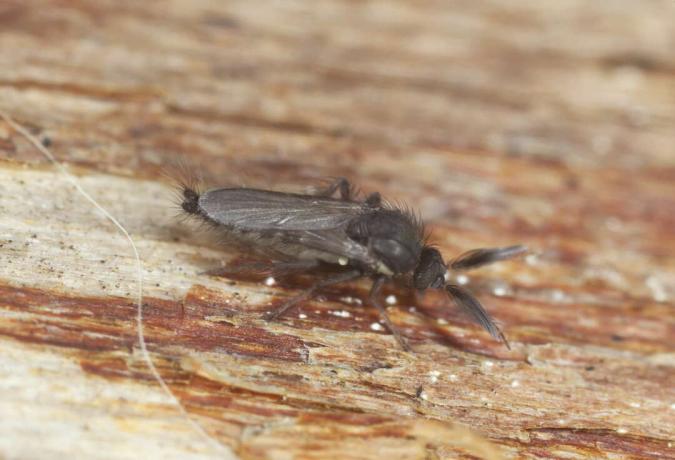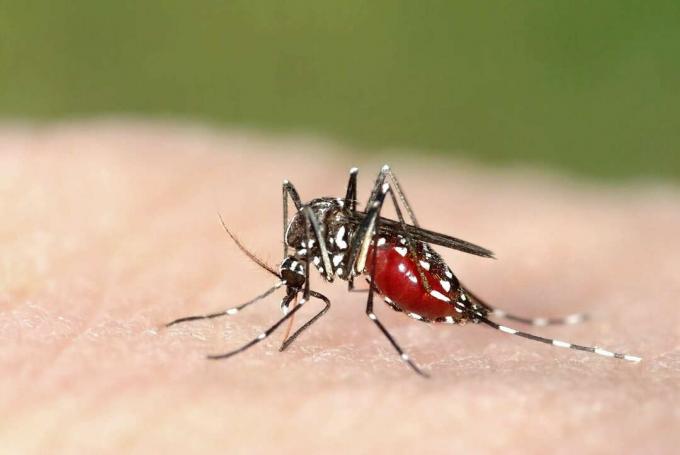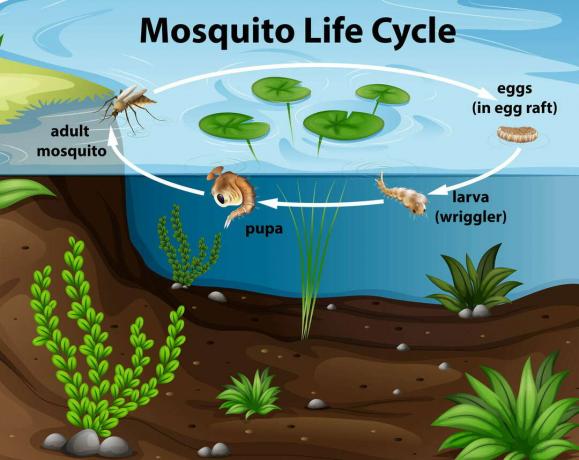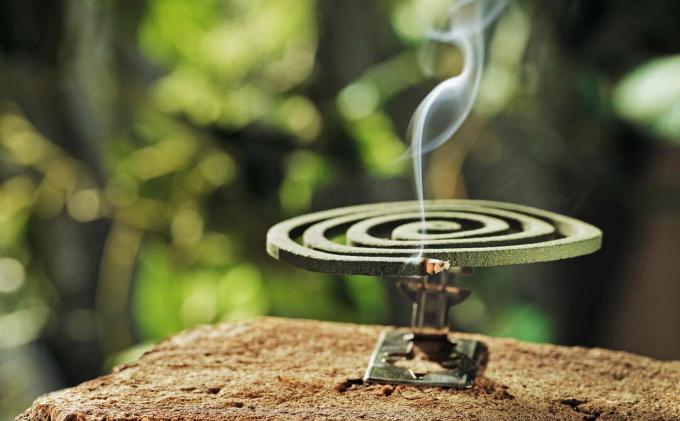Mosquitoes can be extremely uncomfortable. How can you successfully drive away and control the unpleasant insects? We have valuable tips ready.

A nerve-wracking hum in the night, followed by unsightly wheals on the skin and itching that brings one or the other to despair. Most of us associate these things with blood-sucking mosquitoes. Here you can find out what you should know about the unpleasant mosquitoes and what keeps them away.
contents
- Mosquito: profile and information
-
Mosquito species
- House mosquitoes
- Flood mosquitoes
- Invasive mosquitoes
- Lifespan and cycle of the mosquito
-
Drive away mosquitoes and keep them away
- Mosquitoes: are mosquitoes attracted to light?
- Bug spray against mosquitoes
- Mosquitoes: Avoid standing water
-
Fight mosquitoes successfully
- Instructions for mosquito trap
- Home remedies for mosquito bites
Mosquito: profile and information
The insects of the mosquito family (Culcidae) are known by many different names. In Switzerland they are called "Staunsen" or "Stanzen" and in Austria the term "Gelsen" is more common. Lately, the term "mosquito", which is originally derived from the Portuguese and Spanish "mosquito", has been gaining ground.
Mosquitoes can be found almost all over the world. There are a total of 3,500 species - 104 of these mosquitoes are found in Europe.
Mosquitoes basically feed on plant sap, but after mating the females need blood for egg development. The mosquitoes therefore have stinging-sucking mouthparts that have receded in the males. Therefore, only the female mosquitoes can suck blood. When biting, the mosquito injects a salivary secretion, which influences the blood coagulation and enables the mosquito to suckle. The mosquitoes are attracted to their host by the exhaled carbon dioxide and the body odor.
Mosquito species
In the following, we will give you an overview of the mosquito species that romp around in our area. The following mosquitoes are native species:
- Common mosquito (Culex pipiens)
- Flood mosquito (Aedes vexans)
- Large house mosquito or ring mosquito (Culiseta annulata)
- Sand fly (Phlebotominae)
- Black fly (Simuliidae)
- Bearded mosquito (Ceratopogonidae)

These mosquitoes, on the other hand, are invasive species - i.e. mosquitoes that were introduced from often exotic areas:
- Asian tiger mosquito (Aedes albopictus)
- Asian bush mosquito or Japanese bush mosquito (Aedes japonicus)
- Yellow fever mosquito or Egyptian tiger mosquito (Aedes aegypti)
We would like to go into more detail about a few of these mosquitoes or mosquito groups below.
House mosquitoes
These mosquitoes survive the winter in hollow trees, holes in the ground or in frost-free rooms. They are well known to us because this type of mosquito keeps us from sleeping in summer and autumn. In spring, the females look for water points to lay eggs and lay around 150 eggs. In theory, these females can produce up to a billion offspring by the end of the season.
Classic house mosquitoes are Culex pipiens, Culex hortensis, Culiseta annulata.

Flood mosquitoes
The flood mosquitoes lay their eggs in flooded areas, where their clutches wait for water. When a flood inundates this region, the starting signal is given for an explosive occurrence. As soon as the water withdraws, the mosquitoes begin to develop. The adult mosquitoes live relatively short, but the females also need blood to lay eggs and can therefore be particularly annoying. They seek blood from amphibians and wild animals, but also from people who are nearby. These mosquitoes can also be blown near us by the wind, but normally they do not invade houses. Typical types are Aedes vexans, Aedes stiticus or Aedes rossicus.

Invasive mosquitoes
For some years now, mosquitoes from tropical and Asian regions have also increased in Central Europe. These are not only favored by climate change, but rather the cause of the occurrence of these mosquitoes lies in global trade. For example, the Asian bush mosquito (Aedes japonicus) prove.
These mosquitoes are very similar to the house mosquitoes, but they are often found in damp rooms and stables. Here, too, the females can transmit blood plasmodia that cause malaria. To do this, however, the mosquito has to bite a sick person, the pathogen has to complete its development in the mosquito and then the mosquito has to poke a person again. Only then is it possible that malaria can be transmitted. Some examples of mosquitoes that can transmit diseases are:

- The yellow fever mosquito is found in Europe in Turkey, Greece and southern Spain and can transmit dengue fever, Zika virus, yellow fever and chikungunya fever.
- The Asian bush mosquito is native to China, Korea and Japan and can transmit the West Nile virus and cause meningitis.
- The Asian tiger mosquito has its home in southern Asia, but is already sighted in southern Germany and Austria. These mosquitoes can transmit the West Nile virus, dengue fever, yellow fever and Chikungunya fever. It may also be able to transmit the Zika virus.
Lifespan and cycle of the mosquito
It takes about 20 days for a mosquito to develop from an egg to an adult mosquito. The females lay their eggs in stagnant water. The calm surface of garden ponds or rain barrels is ideal for mosquitoes to lay eggs.
Between 30 and 300 eggs can be deposited per egg deposit. The eggs are glued together to form so-called egg boats. They float on the surface through trapped air bubbles between the eggs.

After 3 to 5 days, the first larvae hatch and develop in the water. They have no organs for breathing underwater, only a breathing tube. Most of their food consists of algae and microorganisms. During their development, the larvae molt four times. Depending on the food available, the larva needs 1 to 3 weeks to develop and pupate.
The pupae then float under the surface of the water for a few days. Compared to other insects, the mosquito pupa is still flexible and can even flee in case of danger. The mosquitoes are able to reproduce as soon as they are able to fly.

Large swarms of mosquitoes at dusk consist of a multitude of males. The females fly into these flocks and are located by the males. This works via the different hum frequencies of male and female mosquitoes. Then the females are mated.
After fertilization, the female must consume protein and iron in order for her eggs to develop. These substances are found in the blood (hemoglobin). The females therefore sting their suitable host and take about 0.005 ml of blood. After digestion, which can take 1 to 2 days, the females lay their eggs and can be mated again.
Drive away mosquitoes and keep them away
To prevent itchy wheals, try the following tips to keep the mosquitos away. Especially for those of us who like to sleep with the window open, an insect screen on the windows is highly recommended.
Mosquitoes: are mosquitoes attracted to light?
It is a misconception that mosquitoes are attracted to light. In principle, the nocturnal and twilight-active insects orient themselves on the moon. Our artificial light sources mostly confuse them and they lose their bearings. However, the mosquitoes can get used to our light sources and the hunt for our blood starts again.

As already mentioned, mosquitoes use their sense of smell to orient themselves. If you see mosquitoes buzzing around a light source, you don't have to worry. These mosquitoes are mostly mosquitos (Chironomidae) that don't sting us.
Mosquitoes are attracted to our body odor and the carbon dioxide that we exhale. That is why they always buzz around our heads at night. This is where the carbon dioxide concentration is simply the highest.
Bug spray against mosquitoes
The insect sprays on the market are so-called repellents. Repelling means nothing more than repelling. Repellents or deterrents contain substances that "stink" for the pest. The organism to be deterred usually perceives the substance through its sense of smell and is thereby expelled, but not killed. Often these synthetic sprays are not suitable for children or for pregnant women, who are particularly likely to be attacked by mosquitoes.

Our tip: Homemade bug spray
- Fill 30 ml of peppermint hydrosol into a pump bottle.
- Add 4 drops of peppermint essential oil and 2 drops of tea tree essential oil.
- Spray this spray on your clothes and body every few hours to repel insects.
- The spray also has a cooling and refreshing effect on tired legs.
Wearing the right clothing is also helpful in repelling mosquitoes. Wear long, body-covering clothing (that can be impregnated with insect repellants) but that is not too tight. Otherwise, the mosquitoes can bite through the fabric without any problems.
Mosquitoes: Avoid standing water
As already mentioned, mosquitoes lay their eggs in stagnant water. Therefore, it is best to cover your rain barrels. In your garden pond, frogs and fish can reduce the number of larvae. Unfortunately, there is also the danger that the fish will also reduce the natural antagonists of mosquito larvae, such as the larvae of dragonflies or swimming beetles.
Also watch out for hidden water points such as a forgotten bucket or empty flower pots in which rainwater has collected. Mosquitoes like to develop here.

Fight mosquitoes successfully
If you don't want to spray yourself with bug sprays all summer, there are a few other methods you can use. Since mosquitoes are attracted by our body odor and carbon dioxide, they can be confused and distracted by various plants and substances. Even in the early days, walnut trees were often planted on farms - often near the dung heap, where such insects like to cavort. The released essential oils drive away the mosquitoes.
It is also helpful in the fight against mosquitoes if you spread the scent of essential oils in the room with a fragrance lamp or if you use incense sticks. Citronella, lavender and catnip are especially good.

A tip from the garden for combating mosquitoes is the tomato. Mosquitoes don't like an intense smell at all. Either you plant the tomatoes in front of your bedroom window or you can put some on your balcony. You can find more information about the correct cultivation and care of tomatoes here.
Instructions for mosquito trap
To keep mosquitos at bay, you can easily build a trap. So you can spend your evening in peace in the garden without being visited by the annoying bloodsuckers.
For this trap you will need: sugar, water, yeast, 2 liter plastic bottle, tape
- Cut the plastic bottle in half in half. The middle is usually 10 cm below the neck of the bottle.
- Fill approx. Put 200-300 ml of warm water and about 50 g of sugar in the bottom of the bottle. Mix everything well and let it cool down.
- Add 1 g of yeast. The yeast will break down the sugar, releasing carbon dioxide in the process.
- Now put the top of the plastic bottle upside down (like a funnel) and tape it with some tape to be on the safe side.
- Now set up the trap, ideally in a place where mosquitoes often swim around.
After a very short time you will see that the mosquitoes are flying into the trap and that it is full of dead mosquitos. The effect will of course be lost after a while, when the yeast has broken down all the sugar and the trap is full. Then just renew the water, sugar and yeast liquid.
Home remedies for mosquito bites
If the mosquitoes did work faster and all defense measures did not help, there are some home remedies that can provide relief from the itching. First of all, it should be mentioned that scratching is a very bad idea. It's hard to resist this urge, but you run the risk of inflammation and this only spreads the mosquito's saliva - it only makes the itch worse.
The best remedy for mosquito bites is cooling. Gel compresses, ice packs, ice cubes or cold compresses help with itching and the cold also counteracts inflammation. Make sure that the ice packs or the like are not placed directly on the skin. Always put a tea towel or hand towel in between to protect your skin.

What you must have on hand is an onion. Cut this in half and place the freshly cut onion on the mosquito bite. The onion then unfolds its antibacterial and disinfecting effect and also soothes the itching.
There is sure to be some vinegar in your kitchen when there is no onion. Mixing a little vinegar with cold water makes a great solution that combats the itching. Dip a cotton ball or tea towel in it and place it on the sting. You will soon feel relief.
The leaves of the ribwort (Plantago lanceolata) an insider tip. This herb can be found in almost every meadow. Find a few leaves of the herb and rub it between your hands until some sap comes out. Lay the leaves on the stitch and let them do their job. The itching will soon go away.

Did you already know that there are plants that mosquitoes unfortunately cannot? With these Plants against mosquitoes you can keep the unloved pests out of your garden.
